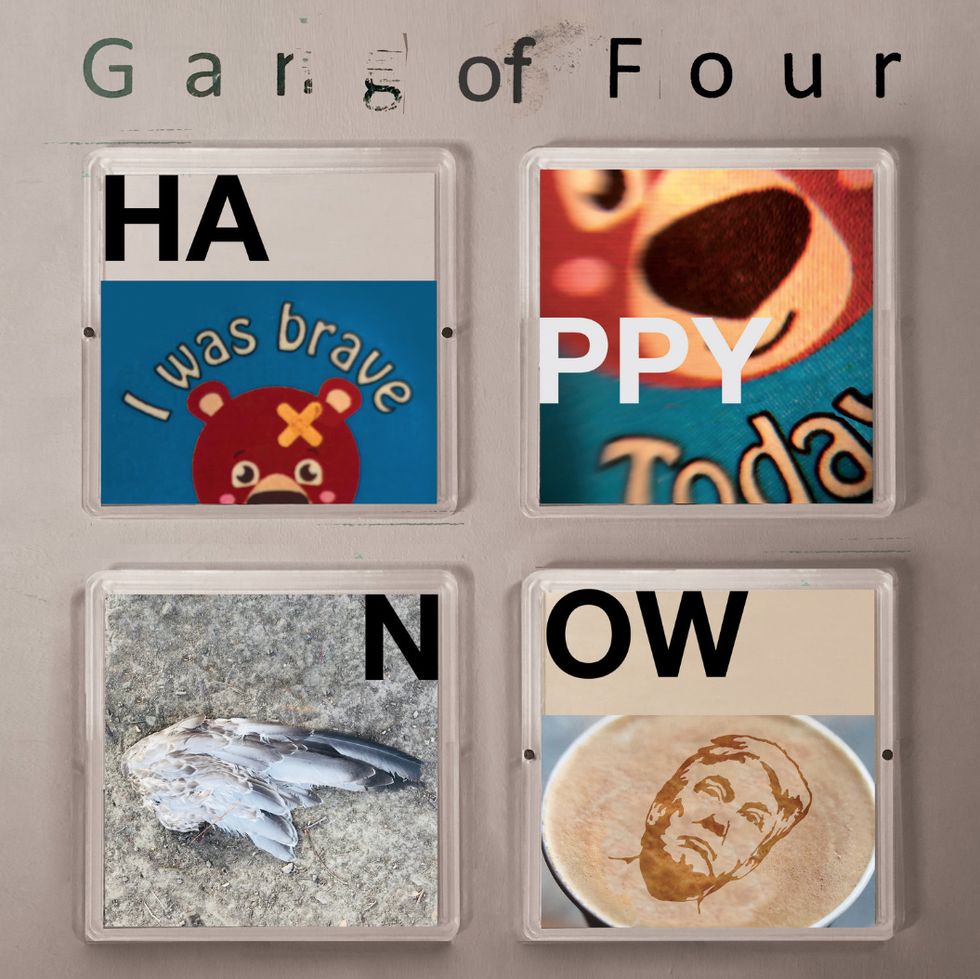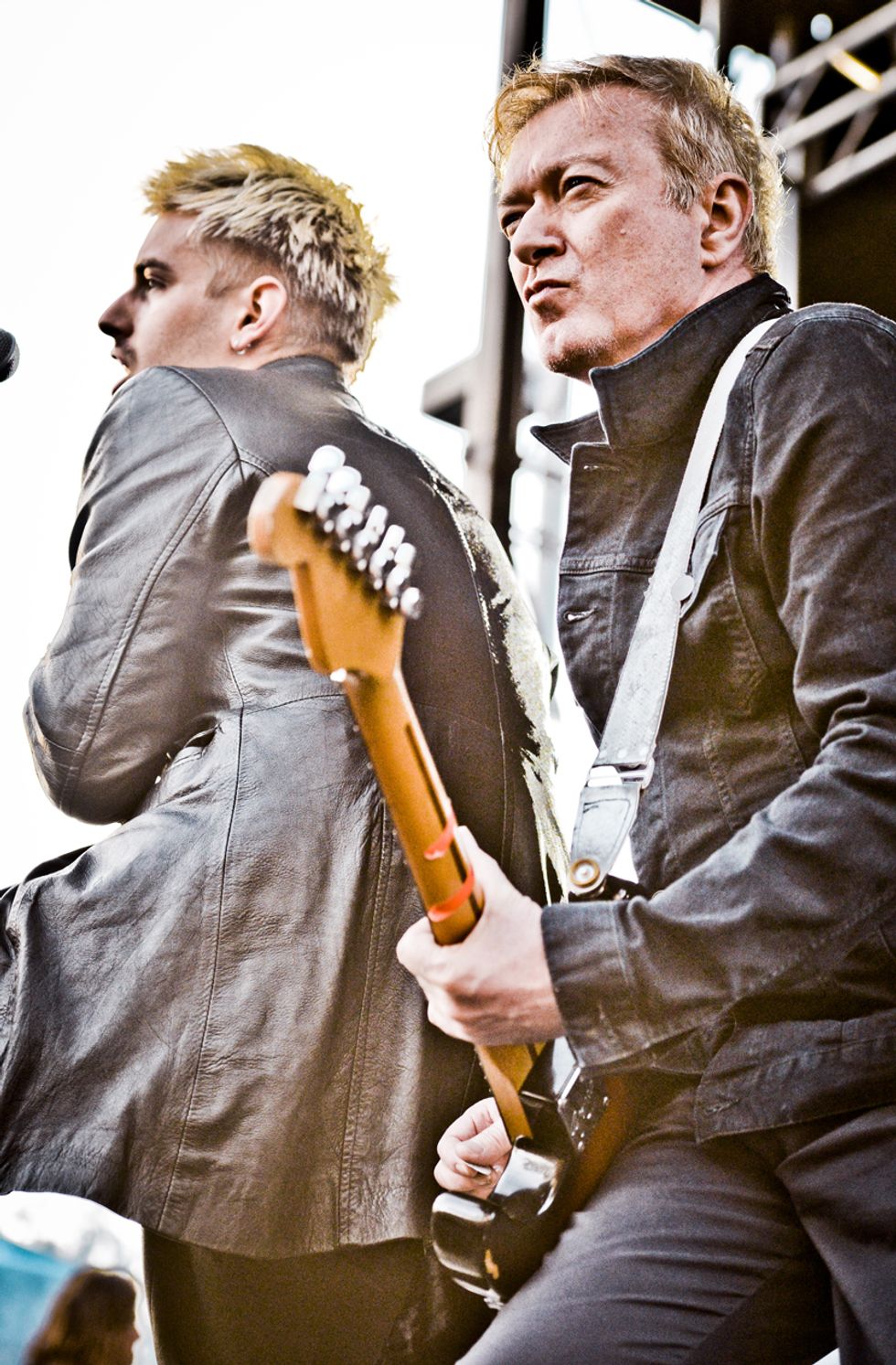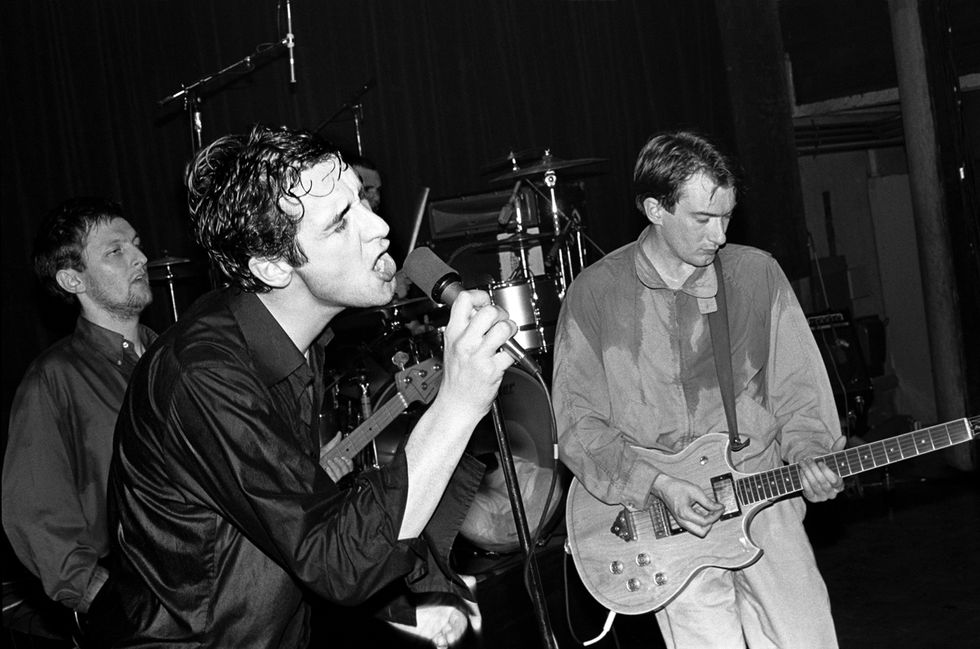Anarchy and exactitude seem like opposites, yet Andy Gill, who’s led the post-punk band Gang of Four since he and singer Jon King formed the quartet at the University of Leeds in 1976, has developed a highly personal 6-string language that comfortably balances both. Gill’s playing on the band’s classic 1979 debut Entertainment! heralded the arrival of a new kind of rock-guitar hero: string slammers who embraced angularity and atonal bombs, crafting braying, churning waves of noise and serrated, dangerous solos.
Others were in on this new game, like David Byrne and the Voidoids’ Robert Quine. And some, with Quine and Gill at the fore, embraced blues and R&B, just as Hendrix and other guitars heroes of the previous generation had done. But they cracked those styles open like cooked lobsters and carefully selected the parts on which they wanted to feast. For Gill, it was the deep groove and rhythmic precision of classic R&B and dub, blended with the explosiveness of Hendrix, but all tailored to a new era.
That’s an aesthetic that produced the disjointed, brittle-toned guitar that Gill splattered all over the groove of “At Home He’s a Tourist,” from Entertainment!, and the seesawing siren calls and beehive rhythm he authored for “What We All Want” from the 1981 follow-up, Solid Gold—the albums that established his influence in the world of free-ranging guitar. Both of those songs also offered incisive critiques of consumer culture, reflecting Gill and Gang of Four’s interest in lyrics reflecting the zeitgeist—at a time when the U.S. and Great Britain were being flooded by a wave of right-wing leadership, even as the Cold War was coming to a supposed end.
For the next four decades, with two hiatuses along the way, Gill and Gang of Four have continued to refine that sound and that perspective. Gill’s wanton destruction of guitar tone has been aided by new developments in digital sound-processing technology, reaching a new apex onstage and in a trio of recent studio releases: the 2015 album What Happens Next, last year’s Complicit EP, and the new album Happy Now.
As Gang of Four was beginning the final leg of a U.S. tour in late February, Gill was hospitalized in New York City for a chest infection. The remainder of the tour was scrapped and, when he sufficiently improved, Gill returned to his home in England. He was there when we spoke via Skype, in improved spirits and condition, obligingly answering questions about his career as a brilliant and purposeful sonic radical who helped change the evolution of rock guitar and continues to experiment with its DNA.
Your playing is like a blend of expressionist and hyper-realist painting: explosions of sonic color blended with Jimmy Nolen-like rhythmic precision, embracing James Brown’s notion of the band as a single organism. Is that something you’ve purposefully done, or is that simply a preposterous conversation starter?
I’ve given a very similar description myself, and there are two very, very diverse ways I go about things. One is sort of, as you say, just crashing through everything else, while the drums and the bass are always a tightly functioning, rigid groove. And you could say the James Brown thing is there. And sometimes the guitar ties in a little bit, and then goes completely off-grid. It’s sort of Hendrix at his most chaotic, or the Velvet Underground, where it kind of gets a little sloppy. And then, at the other extreme, it’s tight and sits right in what the rhythm section’s doing. People that do that are—like, Steve Cropper, and Wilko Johnson at the British R&B end—just millimeter-tight with the groove.
Cropper and Johnson are both Tele guys. You’ve mostly been a Strat player.
I’ve tried Telecasters, and I always thought I should like them. If I was more the one player, it might work, but I want to be able to do both and switch back and forth pretty fast.
More recently I fell in love with the ES-335, which is quite different.It’s thick. I did a couple little solos on the 335 on the low E and A strings, down at the bottom of the neck, and you get this growling, old man kind of sound. It just sounds amazing. Guitar players traditionally go up to the dusty end of the neck when they want to be expressive. But it’s rather amazing if you do the opposite and go low. You get some extraordinary voicings. There’s one of those solos on “Obey the Ghost” [from 2015’s What Happens Next].
What primes your creativity? What do you channel back into your music that’s outside of music?
What you’re trying to do, when you make a song, is make some sort of representation of the world. And the things that provoke you to do that can come from anywhere. You might hear a politician say something on a news program. And then you’ll see it verified by a piece of advertising on the side of a bus. It’s all these kind of weird connections.And you might read a bit of fiction that somehow gives an insight into that thing that you heard earlier. Things cross-resonate, I suppose.
How did you develop the idea of Gang of Four as a precise rhythmic organism?
Well, it wasn’t right out of the box. I was kicking around song ideas in the sense of guitar strumming, guitar picking, with Jon King. We’d throw some lyric ideas around. And then eventually we got in Hugo [Burnham] to play some drums. And, in the early days, a bass player named Dave Wolfson. We found a room that we could borrow, in the [University of Leeds] Student Union.
At that point, that interlocking-ness wasn’t there. And I think I got more and more precise about it, sometimes to Hugo’s frustration, because if you had something that interesting rhythmically on guitar … if that was going to lock in with the drum, with the bass, those parts had better be really well worked out. Otherwise, it’s just not going to work. It’s not that the guitar and the drums are doing the same thing, but they are doing things which hit the same notes at some points, and sometimes they don’t hit the same notes, and that’s kind of what makes the whole thing funky and interesting. We had fights. Hugo would throw his drum sticks at me and say, “Why should I do what you’re telling me to do?” And I would go, “Because it’s important, and I think it’s going to be really good.” And we’d get there in the end.
You certainly did. Entertainment! was such a blast of fresh air: so different and thought-provoking, lyrically and musically. You mentioned Hendrix as an inspiring agent of chaos. I hear that in your playing. But where Hendrix might lay into whammy bar feedback for 30 seconds, you drop these shorter bombs and move on. They’re almost like exclamation points in the songs.

TIDBIT: Gill’s post-recording and plug-in-based signal processing are increasingly devoted to the destruction of conventional guitar tones—an outgrowth of his ongoing interest in the options provided by digital technology.
I remember the Buzzcocks’ manager, Richard Boon, said to me about our songs a long time ago, “Oh, yeah, they’re amazing, they’re really, really good. They go on a bit long, though, don’t they?” [Laughter.] I thought about that. But you know, Buzzcocks’ songs never really went beyond three, three-and-a-half minutes. Anyway, it just stuck in my head. I listen back to things very carefully and think, “Do we need this part? Is this bit necessary?” And I suppose there is something to be said for brevity.
Over the last few albums, you’ve become interested in destroying sound. I know you’re accomplishing some of this through DAWs, but, listening to the guitar and the bass on some tracks, it sounds like you’re purposely eroding and abrading and fragmenting them. What’s the appeal in that?
“Abrading.” Good word, yeah. That’s right. For What Happens Next, what would often happen is I’d just DI the guitar straight into the computer and drop different apps on it, whether they were designed for the guitar or designed for something completely different. I wasn’t interested in all the lovely, beautiful tone of the Celestion speaker and the 12 AX valve. You put that and this on it, and suddenly it was almost like the guitar was fighting for its life. And that can be a quite extraordinary sort of sound. I suppose it’s the same spirit as people in the ’60s, cutting slits in the speakers to fuck them up.
I remember in the early ’80s getting to know synthesizers. “God, you must have to have a degree in electronics to know how to use that thing.” And today, with the digital stuff, you don’t, really. You need a five-minute lesson and then you can get on with it. Of course, nobody had YouTube back then, so a lot of these things, you go see a video and then you play with it, and suddenly the sound comes out, and you use it. Why wouldn’t you?
My favorite bits of sound destruction are done with Dubstation and Replicant by Audio Damage, CamelPhat by Camel Audio, FabFilter stuff, Trash from iZotope, and the Movement delay by Output. They’re all familiar—nothing particularly new.
Having said all of that, there’s still some pedals I find it hard to give up, and they’re fiddly to use, like, for example, the Electro-Harmonix MicroSynth. I love that thing. The trouble is, you can’t play it and move the faders at the same time, and that’s kind of what you need to do. You can set it in one position, and it does some pretty great stuff, but when you start moving it around when it’s being played, it goes to another level.
So you either record your guitar straight and then put it back through the pedal and fiddle with it, and you might have to do that a few times to rehearse whatever it is you’re trying to get, or you get someone else to do that for you while you play. An example of that is “Alpha Male,” on the new record, which is essentially two guitar parts, and they answer each other. It’s like a bar of one, followed by a bar of another, a bar of number one again, a bar of the other. One of them is going through the MicroSynth and the other is just going through the most basic of Logic guitar amps, which is the one that looks like a combo.
Watch Andy Gill's Rig Rundown:
Although he’s most associated with a Strat, Gill—at the back of the band’s current vocalist John Sterry—has also appeared onstage in recent years slamming a Reverend Double Agent and a Gibson ES-335.
One of the hallmarks of the band has been your social perspective. Did living in Leeds when you began writing songs somehow trigger that?
It’s complicated. We went to Leeds University to do art. When I went there in the ’70s, Leeds looked like it had been bombed. There were the remnants of old slums, back-to-back. It’s quite different now. It’s been totally renovated. I grew up in Kent, which was certainly a much, much better-off environment than some of Leeds was in the ’70s.
Sometimes there’s an element of confusion about the political thing. It would be a mistake to think that Gang of Four was always banging the drum for socialism and prescribing certain social changes to make the world a better place. I don’t think that was ever on the agenda. What was on the agenda was much more attempts to describe the world that we saw around us and, on a sort of micro level, what you might call personal politics. And on a more macro level, the things that we saw happening in our country and in our media, and the way things would be presented to us.
On Entertainment!, for example, there’s several examples of talking about Northern Ireland, but not in a generalized sort of way. More specifically, about how those of us on the mainland in England would be getting information through the BBC television, and the way that information was manipulated and presented. In the song “5.45,” the first verse is me talking, and I’m explaining that I’m watching the 5:45 news, and I’m trying to eat some food, but I can’t, because I’m looking at the TV and I can see this terrorist being shot, but there’s no blood. It’s really specific: This is me, consuming news and trying to consume food, and this is what’s being spun as an explanation of what’s going on in another part of our country. I was descriptive and observational in, perhaps, a slightly poetic way. But it wasn’t particularly trying to spell out political solutions or social solutions.
Your music was a perfect soundtrack for the age of Reagan and Thatcher.
Sometimes people think that Entertainment! was a reaction to Thatcher, but when we wrote Entertainment!, Thatcher wasn’t in power. Because it almost sounds like it is a reaction to Thatcher, but the Reagan-Thatcher love affair was a little bit later.
Well, let’s talk more about guitars! What drove you to pick up the instrument?
I had no confidence that I would have any musical talent of any kind, but, as a kid, I liked pop music. When I first saw the Beatles on TV, I was trying to figure out how they changed pitch. I couldn’t see they were pressing on frets. I thought they were maybe fiddling with their tuning heads—maybe that’s how it worked. I mean, I had no idea, but I liked the sound of it, but I didn’t think I had any ability. And then my cousin, who was a couple years older than me, could play quite a few things on the guitar. And he showed me how to play “Satisfaction” by the Stones, which I always think as Guitar Lesson Number One. If ever any kids ask me how to play guitar, I show them that. And once I got it in my head, I played it a million times … couldn’t stop playing it. So, I was addicted at that point, and I thought, okay, so it’s not so hard. Actually, they were lying! It’s easy! And then the same cousin showed me how to play “Voodoo Child.” Then I was away. If you can play that, you can pretty much go on and do anything.
At that point, I’d got hold of an acoustic guitar of some sort. I remember it was quite easy to play. It was in tune all the way up. It had decent action, which is unusual for cheap acoustic guitars. And then, a little bit after that, I actually made an electric guitar—the whole thing, including the neck, believe it or not. I bought fret wire and the parts and the pickup through the post, and I made the whole thing in the woodwork class at my school. So, obviously, the neck had no truss or anything. It was literally a lump of wood. But it was playable. Amazingly. And the strange-but-true twist to the story is that I sold it to Kevin [Lycett] in the Mekons. I think he gave me £15 pounds for it. It was painted bright orange. [Laughs.]

Guitars
’80s Fender Strat Ultra with kill switch
Reverend Double Agent
Gibson ES-335
Amps
Two Peavey Classic 50 4x10s
Various plug-ins
Effects
Various effects patches via laptop
Boss TU-2 Chromatic Tuner
Focusrite Scarlett 2i4 audio interface
Two Tech 21 MIDI Moose switchers
Two Radial ProD2 DIs
Electro-Harmonix MicroSynth
Strings and Picks
Ernie Ball 2222 Hybrid Slinky (.009–.046)
Various .60 mm or .73 mm picks
You may have heard that the Mekons and Gang of Four worked very, very closely together at Leeds. We were mates and we worked a little bit as a collective. We got fed up playing in pubs and clubs. They charged us a small amount for using their PA systems. This annoyed us, so we made our own out of old wardrobes and cupboards, and put speakers in them, and we’d carry them around. Hugo had a transit van, which is the main reason he got the job [laughter], but the PA would go around in his transit van.
Did you already have your first Strat when you sold the guitar you built?
I must have, yeah. Somebody made me a Strat copy, and at the very, very beginning of the band, I had an Ibanez SG-style that I really, really liked. There are photographs of me playing that at Gang of Four gigs. I think I got my first genuine Strat at a pawnshop in New York in ’76, when Jon King and I went there.
What brought you and Jon to New York in ’76?
I’d been given a small grant from the University. You had to present something that you were going to write about to get this grant, and I said I was looking into the art of [minimalist and abstract painter] Frank Stella, and so I had to go to the Museum of Modern Art. My professor at Leeds, Tim Clark, who was a well-known art historian, wrote me a letter for someone he knew at the museum in New York that said Andy Gill here wants to come and look in your basement at all the various Frank Stellas. And that’s what happened.
But that’s what I did by day, and by night, we were staying with Mary Harron [film director and cofounder of Punk magazine], who neither of us knew. She was a friend of my friend, Adam Curtis, who makes films in the U.K. He said to Mary, “Is it okay if these two guys turn up and sleep on your floor?” So, we turn up at her apartment in downtown. She was writing for Punk magazine. And she would take us around at night. Pretty much every evening we’d go out to clubs. At CBGB, I remember standing between Joey Ramone and John Cale, having beers with them, and chatting about stuff, and, you know, feeling “this is all very normal.” Then the Jam turned up at CBGB and we watched them, and we’d have a chat with Paul Weller and Paul Weller’s dad, who was managing them then. And we got to be friends with the Patti Smith group. And Jay Dee Daugherty, the drummer, he was particularly a very nice guy. That was a great time—fantastic! It was like: This is normal, anyone can do this, I can do this. Okay, when we go back to Leeds, we’ll do some gigs. So it was, literally, the beginning of Gang of Four.
Zooming ahead a few decades, you were an early adopter of MIDI and really enjoy recording with a DAW and plug-ins. What was the lure of digital music tech for you?
Pretty much as soon as samplers appeared, I was a very early adopter of the Akai sampler from, like, day one. And I’d heard talk about the Atari having a MIDI port on it. So, you could plug straight in, and it just was so simple. And next came Performer software or something. So, the idea of using computers with bands that I produced or music that I was making…. I was involved pretty much from the word go.
Initially, recording was pretty rubbish, but you could do it. And it became slightly better quality and a little bit less expensive. It all struck me as exciting and opening up frontiers.
In the digital recording versus tape debate, I’m a digital fan, but the argument’s made that guitars sound better on tape—with a richer midrange.
Tape does have a sound, yeah, but lots of other things have a sound, too. The sound of my Massenburg EQ is pretty awesome, but I wouldn’t always take that in preference to the Massive Passive. Do you know what I mean? That’s not the only sound available in your toolbox.
Andy Gill, with an Ibanez double-cutaway guitar, singer Jon King, and bassist Dave Allen bring their churn ’n’ burn to New York City’s Irving Plaza on one of their first American tours, supporting their debut album, Entertainment!.
Photo by Ebet Roberts
Are you always working on new songs, or is it, “It’s album time! Go!”
It does tend to be “It’s album time! Go.” On Happy Now, that was very much the way I felt about it. I wanted to completely, totally immerse myself in it, and not pay attention to emails or anything, really, except for the most important stuff. And also, the thing that I decided about this record was to work with co-producers. In the past, people have said to me, or I’ve said to myself, “Ah, well, Andy, you’re a producer. You’ve produced all these other people, so you should do it.”
But when you stand back and think about it, when I’m in the studio, I want someone to give me feedback on a lot of different levels: audio approaches, arrangements. If necessary, argue with me, or whatever. So that’s what I did with this last record. And several different people worked with me on different songs.
I found I was starting very, very early. I’d often be up at 6 a.m. and get a cup of tea and go straight into the studio and be working on lyrics, melodies. And then, by the time the other people that I was working with turned up, like 10:30 or 11:00, I’d already got a whole bunch of stuff done, and then we’d work the rest of the day until 7 p.m. For one of the first times doing music, I realized the power of momentum and how that’s a self-feeding engine that gets things done.
I’ve got a lot of songs left over. Some of them are mixed, some aren’t, and some are still in a demo phase. So, I’ll be back on the album thing later this year.
One last thing: What makes you happy and keeps you going?
Friends and relatives, and just going through and doing a good job. Regularly albatrosses fly in, dropping grenades, and to survive and to achieve a few things is a great source of satisfaction.
It makes you feel like life has balance.I don’t know if I’d go so far as to say that. [Laughter.]
Join the Gang of Four—Andy Gill, singer Jon King, original drummer Hugo Burnham, and bassist Sara Lee—onstage for this fire-breathing rendition of “What We All Want,” from their classic debut album Entertainment! Gill alternates between rhythmic scratching, like a post-punk Jimmy Nolen, and fragmented-bell-toned whale calls of lead guitar. This year, 1982, the band opened for the Police while touring behind their own Songs of the Free album.









![Rig Rundown: Russian Circles’ Mike Sullivan [2025]](https://www.premierguitar.com/media-library/youtube.jpg?id=62303631&width=1245&height=700&quality=70&coordinates=0%2C0%2C0%2C0)






















![Rig Rundown: AFI [2025]](https://www.premierguitar.com/media-library/youtube.jpg?id=62064741&width=1245&height=700&quality=70&coordinates=0%2C0%2C0%2C0)




















 Zach loves his Sovtek Mig 60 head, which he plays through a cab he built himself at a pipe-organ shop in Denver. Every glue joint is lined with thin leather for maximum air tightness, and it’s stocked with Celestion G12M Greenback speakers.
Zach loves his Sovtek Mig 60 head, which he plays through a cab he built himself at a pipe-organ shop in Denver. Every glue joint is lined with thin leather for maximum air tightness, and it’s stocked with Celestion G12M Greenback speakers.











